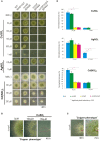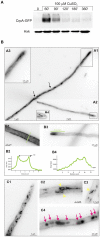Copper Resistance in Aspergillus nidulans Relies on the PI-Type ATPase CrpA, Regulated by the Transcription Factor AceA
- PMID: 28611736
- PMCID: PMC5447758
- DOI: 10.3389/fmicb.2017.00912
Copper Resistance in Aspergillus nidulans Relies on the PI-Type ATPase CrpA, Regulated by the Transcription Factor AceA
Abstract
Copper homeostasis has been extensively studied in mammals, bacteria, and yeast, but it has not been well-documented in filamentous fungi. In this report, we investigated the basis of copper tolerance in the model fungus Aspergillus nidulans. Three genes involved in copper homeostasis have been characterized. First, crpA the A. nidulans ortholog of Candida albicans CaCRP1 gene encoding a PI-type ATPase was identified. The phenotype of crpA deletion led to a severe sensitivity to Cu+2 toxicity and a characteristic morphological growth defect in the presence of high copper concentration. CrpA displayed some promiscuity regarding metal species response. The expression pattern of crpA showed an initial strong elevation of mRNA and a low continuous gene expression in response to long term toxic copper levels. Coinciding with maximum protein expression level, CrpA was localized close to the cellular surface, however protein distribution across diverse organelles suggests a complex regulated trafficking process. Secondly, aceA gene, encoding a transcription factor was identified and deleted, resulting in an even more extreme copper sensitivity than the ΔcrpA mutant. Protein expression assays corroborated that AceA was necessary for metal inducible expression of CrpA, but not CrdA, a putative metallothionein the function of which has yet to be elucidated.
Keywords: Aspergillus nidulans; PI-type ATPase; copper homeostasis; copper resistance; metallothionein; transcription factor.
Figures





References
LinkOut - more resources
Full Text Sources
Other Literature Sources
Research Materials
Miscellaneous

